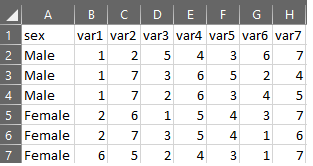Hi,
I wish to plot 7 barcharts next to each other using a ggplot2 facet grid (I believe this to be correct).
I have managed to come up with a solution by utilising the grid.arrange package, however the code is bloated and repeats itself:
var1<- ggplot(df, aes(var1)) + geom_bar(stat="count")
var2<- ggplot(df, aes(var2)) + geom_bar(stat="count")
var3<- ggplot(df, aes(var3)) + geom_bar(stat="count")
var4<- ggplot(df, aes(var4)) + geom_bar(stat="count")
var5<- ggplot(df, aes(var5)) + geom_bar(stat="count")
var6<- ggplot(df, aes(var6)) + geom_bar(stat="count")
var7<- ggplot(df, aes(var7)) + geom_bar(stat="count")
grid.arrange(var1, var2, var3, var4, var5, var6, var7, ncol = 4, nrow = 2)
This code produces 7 separate barcharts and places them in a 2 x 4 grid.
As mentioned, this code seems far from efficient.
I have tried playing around with ggplot2 facet_grid but I can't seem to get it to work how I want. As all the online videos/forum posts state that you need to define x/y. But I want the Y axis to be the count of each column and X to be going from 1 to 7, as per the ranking (In my data, the numbers represent ordinal data. As each var was ranked against the other, with 1 being the highest)
The following produces one barchart:
ggplot(df, aes(x = var1)) +
geom_bar(stat="count") +
facet_grid()
I understand this is due to only specifying one column, however I'm not sure how to add the other columns so it produces multiple charts. Also, I have no clue what I would put in the facet_grid() argument.
Example of my data:

In my data, the numbers represent ordinal data. As each var was ranked against the other, with 1 being the highest.
"sex" is in there, however I do not want to use that in the facet_grid() argument. It can be ignored.
Apologies if I'm just completely misunderstanding things, I just feel at a loss after hours of trying to get this to work.